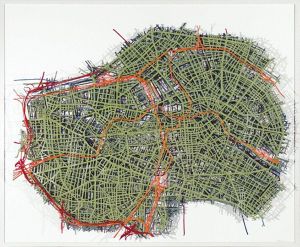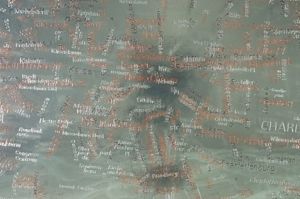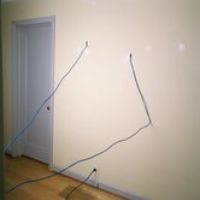With rare exceptions, Matthew Picton‘s work is more satisfying to ponder than see. His ideas are rigorous, his delivery limp.
Take his Postwar Landscape, An Urban History at Howard House. These documentary urban landscapes purport to show past and present in layers, all visible at once. If Harry Potter had one that worked in his debut novel, he wouldn’t have needed those profitable sequels to understand his own story.
Anselm Kiefer paints the Nazi past as poison leeching into the present, but covering the same plot of ground and history, Picton is recessive, letting the facts speak for themselves.
Except they don’t. Below is Picton’s Berlin, 20008, in duralar, enamel paint and pins, 45″ x 55″ x 3″.

What is evoked here? I see nothing but tricky clutter. Below is another version of the same idea from Picton, and this is the one piece in his show that connects. Underneath a contemporary street name is the Hitler Platz in translucent Jello-shades of lime over strawberry: Berlin Text Work #2, 1943, 1962, 2007 – laminated duralar, from 2007.

Other Seattle critics are more favorably inclined. Here’s a Jen Graves preview of the same show, and an Adriana Grant review.
Maps in general leave me cold. My brainy brother who refused to admit he needed glasses once pulled his car over in a rainstorm to try to read a map’s small print in the headlights as the paper puddled in his hands. Sitting in the passenger seat I thought, that’s the way maps are for me all the time.
On the other hand, Fred Muram‘s version – I’ll let you drive if I can read the map, 2009 – is my idea of soul food.




Leave a Reply